Christy Chan
Art 1010 Final Paper
Prof. Shaw
12/11/18
We all know that art is limitless, and can mean so many things to the artists. Art is not only just a simple 2-dimensional thing; it can take forms in other ways, such as jewelry. Nowadays jewelry is more of a fashion statement piece for us to show off our ensemble, but in ancient times jewelry had a more important role. In the ancient times such as the Hellenistic period, and ancient Egyptian period, jewelry was made to coordinate with their gods and goddess, and were used as either protective amulets or to glorify statuses.
Previously jewelry was made from bones, animals, and other varies hard like materials, but due to the abundance of gems, metals, and gold in Ancient Egypt, a new type of jewelry was inspired by and created to worship gods/goddesses, royalty, and high-level position figures. Gold jewelry is a symbol of power, religion, and status, and Egyptians were fond of using colored glass, and it was expensive due to its rarity. Egyptians also love designs with scrolls, tigers, scarab beetles, winged birds, jackals, antelopes, and tigers.
“Protective amulets could be worn as independent pieces, but they were often fused into Egyptian jewelry. These amulets were talismans or charms that were believed to either infuse the amulet with power or to protect the wearer. The amulets were carved into various shapes and forms, including symbols, humans, animals, and gods. Additionally, the amulets were seen as equally significant protectors of the living and the dead. Amulets were made specifically for the afterlife, as memorial jewelry was customary for ancient Egypt” (Ancient Egyptian).
 Take a look at the wreath, this piece belongs to the ancient Egyptians, the wreath is made with gold and was used to crown athletic victories throughout the ancient Greek time. This shows the symbol of victorious men’s through their accomplishment, and not only was this used during the Egyptian times; it was also used during the Hellenistic period.
Take a look at the wreath, this piece belongs to the ancient Egyptians, the wreath is made with gold and was used to crown athletic victories throughout the ancient Greek time. This shows the symbol of victorious men’s through their accomplishment, and not only was this used during the Egyptian times; it was also used during the Hellenistic period.
 The Ring of Cat and Kittens is used to symbolize as the “faraway goddess”, the cat is supposed to be a deity that ran away from the Nubian Desert and had to go back to the Nile Valley. This symbolism is to bring prosperity back to Egypt. Rings like this are most likely created to celebrate various festivals in honor of the deities depicted on the rings.
The Ring of Cat and Kittens is used to symbolize as the “faraway goddess”, the cat is supposed to be a deity that ran away from the Nubian Desert and had to go back to the Nile Valley. This symbolism is to bring prosperity back to Egypt. Rings like this are most likely created to celebrate various festivals in honor of the deities depicted on the rings.
“In the Hellenistic period, the Greek world was flooded with gold. Greece itself had few sources of gold, and those had been depleted by the late Classical period. Alexander the Great’s conquest of the Persian Empire, which included Egypt, made vast resources of gold available for the first time. The various royal courts of Alexander’s successors, including the Ptolemais in Egypt, comprised a wealthy clientele with a taste for luxury, which, in combination with this new abundance of gold, led to an immense outpouring of gold jewelry” (Roadsrunner).
“In Hellenistic times, jewelry was often passed down through generation. Occasionally, it was dedicated at sanctuaries as offerings to the gods. There are records of headdresses, necklaces, bracelets, rings, brooches, and pins in temple and treasury inventories, as, for example, at Delos. Hordes of Hellenistic jewelry that were buried for safekeeping in antiquity have also come to light. Some of the best-preserved samples come from tombs where jewelry was usually placed on the body of the deceased. Some of these pieces were made specifically for interment; however, most were worn during life” (Ancient Greek Jewelry).
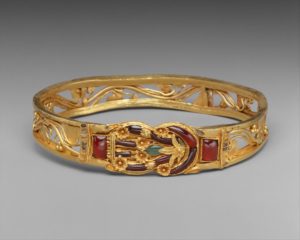 The Gold armband with Herakles knot is a gold bracelet inlaid with emeralds, enamel, and garnets. It was believed that any Hellenistic jewelry with a Herakles knot was known to have the power to thwart evil and cure wounds.
The Gold armband with Herakles knot is a gold bracelet inlaid with emeralds, enamel, and garnets. It was believed that any Hellenistic jewelry with a Herakles knot was known to have the power to thwart evil and cure wounds.
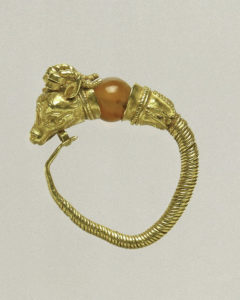 This is a goat head earring during Hellenistic times. During the Ancient Greek time, they believed the goat is closely related to one of their God Dionysus later known as Bacchus in the Roman period (the god of wine and fertility). It was believed that the goat was related to men, and it was associated with burning sexuality and lasciviousness and lust. Since jewelry was made for mainly women and was used to appeal to the opposite sex, you can say that this goat earring is made to attract males to females, and to show that they can be fertile.
This is a goat head earring during Hellenistic times. During the Ancient Greek time, they believed the goat is closely related to one of their God Dionysus later known as Bacchus in the Roman period (the god of wine and fertility). It was believed that the goat was related to men, and it was associated with burning sexuality and lasciviousness and lust. Since jewelry was made for mainly women and was used to appeal to the opposite sex, you can say that this goat earring is made to attract males to females, and to show that they can be fertile.
As time goes on, the significance and history of jewelry get lost. The Greeks and Egyptians all had a religious belief and status to uphold making all jewelry important in their culture and looked up upon. Most jewelry nowadays does not have any symbolism behind them, no longer do we have a beautiful story or importance in our jewelry. How often can you be able to say that this piece of jewelry is made to protect you, thwart off evil, cure your sickness, or even to say it was based off a certain god or goddess? Is it important enough to be passed down generations to generations or make you stand out and show off your status? This obviously doesn’t apply to diamonds because diamonds are just an expensive gemstone now that will last forever, with its own distinguished statement, but for regular jewelry or common gold jewelry, it’s nothing more than a flashy statement piece.
Works Cited/Resources
“Ancient Egyptian Jewelry.” Gem Rock Auctions, 13 Feb. 2017, www.gemrockauctions.com/learn/did-you-know/ancient-egyptian-jewellery.
“Ancient Greek Golden Jewellery.” Poseidon the Greek God of Sea, www.greek-islands.us/ancient-greece/ancient-greek-jewels/.
“Ancient Greek Jewelry.” Ancient Greece, www.ancientgreece.com/s/Jewelry/
https://www.brooklynmuseum.org/opencollection/objects/25429
“Hellenistic Jewelry.” The Roadrunners’ Guide to Ancient World, 11 Dec. 2013, roadrunnersguidetotheancientworld.com/hellenistic-jewelry/.
https://www.metmuseum.org/art/collection/search/256970
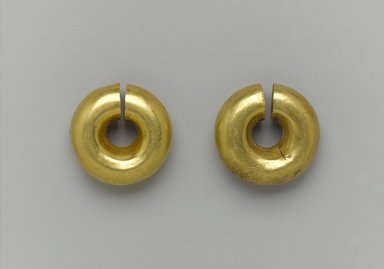 Two Earrings, from Brooklyn museum 1539-1292 B.C.E.
Two Earrings, from Brooklyn museum 1539-1292 B.C.E. 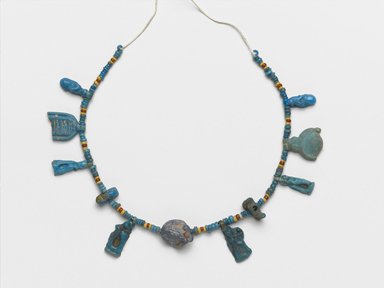 Single-Strand Necklace, Brooklyn Museum 13 32-1292 B.C.E.,
Single-Strand Necklace, Brooklyn Museum 13 32-1292 B.C.E., 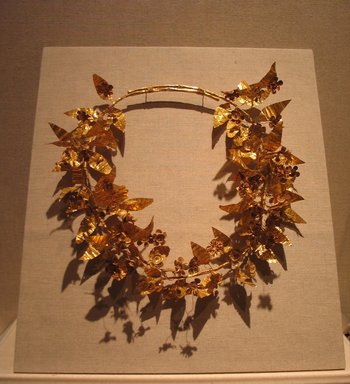 Wreath, Brooklyn Museum 3rd century-2nd-century B.C.E.
Wreath, Brooklyn Museum 3rd century-2nd-century B.C.E. Ring in the Form of a Coiled Serpent from Brooklyn Museum 3rd century B.C.E.
Ring in the Form of a Coiled Serpent from Brooklyn Museum 3rd century B.C.E. 
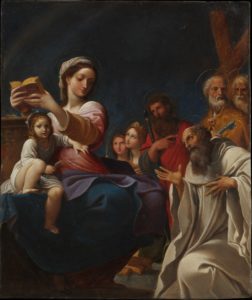 1600-1750s then it was considered Baroque. Baroque artwork was also heavily influenced by the Roman Catholic Church around that time period hence the religious artwork with crucifixion and Madonna.
1600-1750s then it was considered Baroque. Baroque artwork was also heavily influenced by the Roman Catholic Church around that time period hence the religious artwork with crucifixion and Madonna. 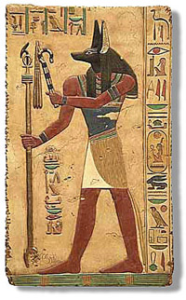

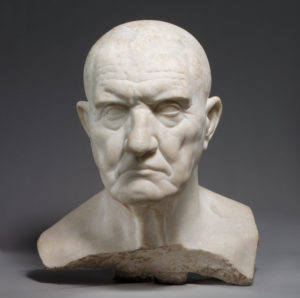

 head floating on the tree, and the broken stained glass on the tree. This is such a powerful piece because it shows the artist trying to put in all the troubles that the African Americans suffered through. The brightest part of this whole painting is the white clouds that looks like it’s on the horizon with the crosses out of the clouds, but right in front of it is the protest for freedom and a crucifixion on fire. This is one of Motley’s last piece after finishing within the span of 10 years, and I would say this a great last piece of his to portray the Black social life.
head floating on the tree, and the broken stained glass on the tree. This is such a powerful piece because it shows the artist trying to put in all the troubles that the African Americans suffered through. The brightest part of this whole painting is the white clouds that looks like it’s on the horizon with the crosses out of the clouds, but right in front of it is the protest for freedom and a crucifixion on fire. This is one of Motley’s last piece after finishing within the span of 10 years, and I would say this a great last piece of his to portray the Black social life.
